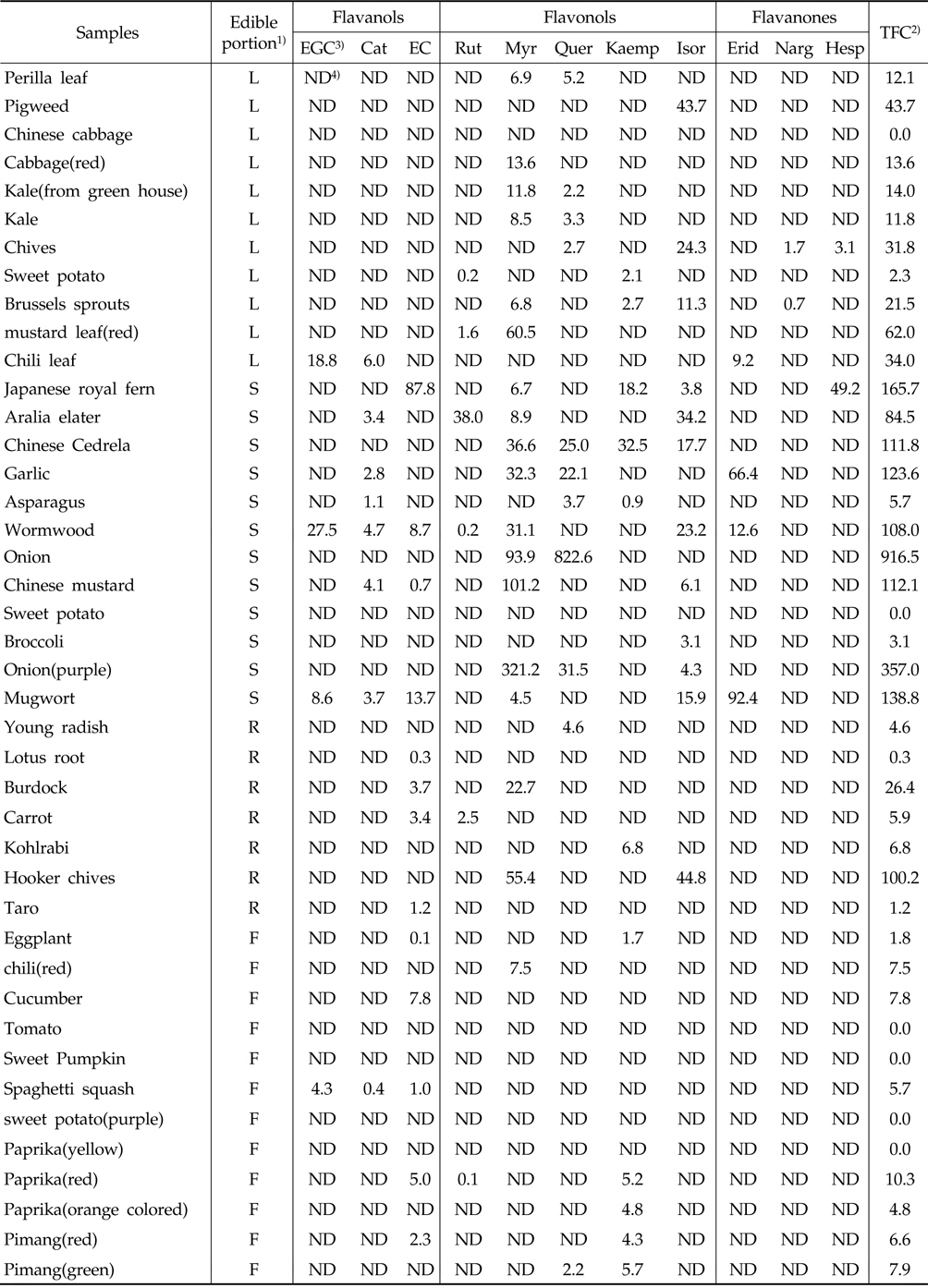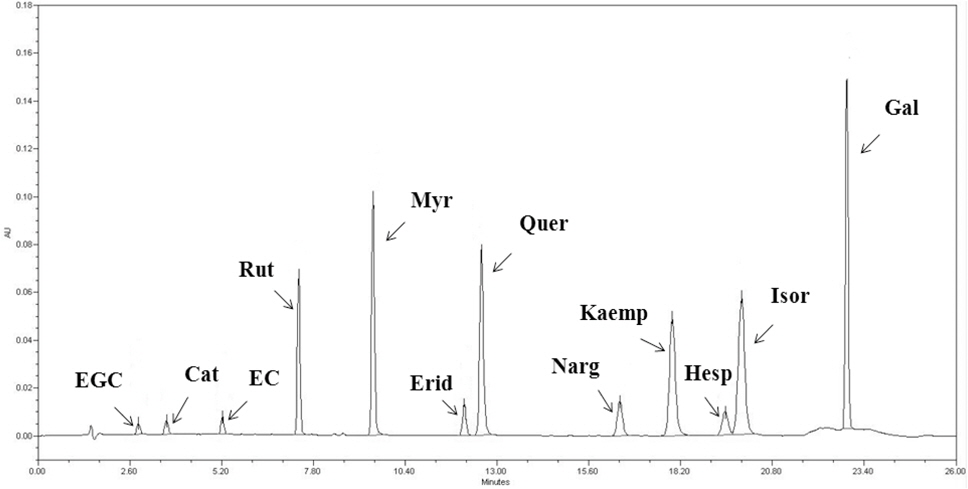



This study focused on the contents of flavonoid compounds in vegetables. Generally vegetables have contributed to a healthy diet, arisen from contains a large amount of fiber and functional ingredients. And flavonoid compounds are one of major functional components in the vegetables. currently research of flavonoid contents does not enough, specially in the part of homegrown vegetable.
Vegetable samples were purchased in domestic market. Sample extraction by methanol, distilled water, and formic acid based solvent. Also same solvent used for mobile phase in UPLC. Eleven types of flavonoid compounds were analyzed with same kind of external standard and one kind of internal standard (galangin) for quantification. Standard calibration curve presented linearity with the correlation coefficient R2 > 0.98, analysed from 1 to 50 ppm concentration. The quantitative value and multivariate analysis results were derived from the Excel and SIMCA-P11. Overall, onion has largest amount(916.5 ㎎/100 g) of flavonoid and also other vegetables have has significant amount[Mugwort: 138.8, Galic stem:123.6 ㎎/100 g etc.] of flavonoid compounds. Edible portion of vegetables per share for simulating by SIMCA-P11, root vegetables has had difference with other vegetables according to distributions and amounts of flavonoid compounds.
Optionally, the results from this experiment can use to select the material for flavonoid researches. And based on these results, if this experiment will be continuously complemented, and performed, could used in various fields.
채소류는 일반 영양소적인 가치는 낮으나 섬유소와 건강에 유효한 기능성 물질을 다량 내포하고 있어, 국내 식습관이 가파르게 서구화된 현재 필수적인 식이식품으로 높은 관심을 받고 있다. 통계청(2014)에 따른 전체 연령대의 국민 건강 식생활 실천율 조사 결과 2005년 평균 25.4%의 실천율이 2012년 현재 31.4%로, 건강에 대한 국민적 관심이 지속적으로 상승해왔고 또한, 계속적으로 상승할 것임을 암시하였다. 식품 중 특히 현대 식생활에 비추어 건강과 불가분의 관계를 갖는 채소류는 일반적으로 알려진 바와 같이 다양한 기능성 물질이 함유 되어 있는데, 이 중 플라보노이드 계열 화합물은 기본적으로 비타민C와 같은 강한 항산화 효과(Anna
플라보노이드 화합물은 이미 수 천종 이상 탐색(Holden
본 연구는 국내 식품 유래 채소류의 플라보노이드 성분 중 플라바놀, 플라보놀 및 플라바논에 대한 함량조사를 수행하여 부분적이나, 국내 관련 연구자들의 함량 기준의 소재 선별 등의 기초 자료로서 플라보노이드 연구 방향성 설정에 도움이 되고자 수행되었다.
실험에 사용된 증류수, acetonitrile, ethanol, hydrogen chloride 및 methanol은 Fisher Scientific(USA)을, formic acid는 Junsei(Japan)를 사용하였으며, 전처리시 산화방지를 위해
고비나물 등을 포함하는 국내산 채소류 총 42 종을 사용하였으며, 본 시험에 사용된 시료의 목록은 Table 1과 같다. 시료는 동결건조 후 곱게 분말화 하였고 -80℃ 에서 추출단계 전까지 보관하였다.

The composition and content of flavonoids in 42 vegetables by edible portion (㎎ /100 g dry weight)
전처리방법은 Rosa(Rosa
플라보노이드 정량 분석을 위해 tunable UV detector를 장착한 Ultra Performance Liquid Chromatography : UPLC(Waters, USA)를 사용하였다. Acquity UPLC BEH C18 (2.1 × 150 mm, i.d., 1.7 ㎛, Waters, USA) 컬럼을 사용하였으며, 이동상으로는 용매 A(1% formic acid in water) 및 용매 B(0.1% formic acid in acetonitrile)를 사용하였다. 유속은 0.5 ㎖/min으로 일정하게 흘려주었으며, 7%의 B용매로 시작하여 2분까지 12%, 5분까지 17%으로 증가시킨 후 10분까지 17%를 유지하였다. 그리고 12분까지 25%로 증가시킨 후 17분까지 25%를 유지하였으며, 이어서 19분까지 50%로 증가시킨 후, 24분까지 50%를 유지하였다. 다시 2분 동안 7%로 되돌아온 후 2분간 안정화시켰다. 관측에 사용된 UV값은 단일파장 259 nm이고, 시료주입량은 1 μl으로 하였다. 본 분석에 사용된 외부 및 내부표준물질의 크로마토그램은 Fig. 1과 같다.
시료 내 플라보노이드는 외부 및 내부 표준법을 함께 사용하여 정량하였다. 외부표준물질 11종은 각각 1, 5, 10, 20 ppm의 농도 단계로 제조하여 검출된 면적을 기준으로 선형방정식 도출에 사용되었다. 내부표준물질은 galangin을 1000 ppm으로 제조한 후, 분석 시 최종 농도가 50 ppm이 되도록 하였다. 실험 중 발생하는 오차 보정을 위해 RF(Response factor, RF)값을 구하여 아래와 같은 함량 계산식에 적용하였다.
시료내 개별 플라보노이드 함량(mg/100 g dry weight) = (Y=aX+b)×RF×전체용매량×시료중량/1000Y: ppm (㎍/㎖), X: peak area (counts)
다변량 통계 분석은 모든 시료의 플라보노이드 정성 및 정량 정보 데이터를 바탕으로 정렬, 표준화한 후, SIMCA-P 11.0 software(Umetrics, Umea, Sweden)의 부분최소자승 판별법(Partial least squares of discriminant analysis: PLS-DA) 모델을 통해 클러스터 분석을 하였다. Epigallocatechin 외 10개의 플라보노이드 개별 화합물과 마흔 두가지의 시료를 다변량 변수의 X, Y 대표변수로 사용하였고 시료의 주요 가식부 유형에 따라 네 가지(잎, 줄기, 뿌리 및 과일형)로 나누어 그룹(class) 설정을 하였다.
42종 채소류의 부위별 플라바놀류(epigallocatechin, catechin, epicatechin), 플라보놀류(rutin, myricetin, quercetin, kaempferol, isorhamnetin) 및 플라바논류(eriodictyol, naringenin, hesperetin)의 개별 함량 및 총량은 Table 1과 같다. 총 플라보노이드 함량이 가장 높은 채소는 양파로써 퀘르세틴 (quercetin, 822.6 ㎎/100 g)을 주성분으로 하여 916.5 ㎎/100 g인 반면, 배추, 고구마줄기, 토마토류, 단호박 및 노란 파프리카는 플라보노이드 화합물이 거의 검출되지 않았다. 이러한 결과는 Chun 등(2003)이 배추에서 미량(0.06 ㎎/100 g)의 플라보놀류만 함유되어 있다고 보고한 결과와 거의 차이가 없었다. 또한 Lugasi and Hovari(2002)가 호박에서 플라보노이드 화합물이 없다고 발표한 결과와 비슷하게 나타난 반면, 국수호박은 5.7 ㎎/100 g의 플라바놀군 화합물을 함유하고 있어, Jeng(2009)이 제시한 결과와는 다소 다르게 나타났다. 채소류 내 총 플라보노이드 함량 분포는 Fig. 2와 같다. 모든 시료의 함량 범위는 0.0-916.5 ㎎/100 g 이었으며, 200 ㎎/100 g 미만까지는 골고루 분포하였다.
플라바놀류는 대표적으로 녹차잎 내 다량 함유되어 있는 것으로 알려진 화합물이다. 이들 중 카테킨(catechin), 에피카테킨(epicatechin) 및 에피갈로카테킨(epigallocatechin)을 분석하였으며, 고비나물 등 12종의 시료에서 확인된 에피카테킨은 카테킨 또는 에피갈로카테킨에 비하여 전반적으로 분포가 많았을 뿐만 아니라 특히 고비나물(87.8 ㎎/100 g)은 가장 높은 에피카테킨 함량을 나타냈다. 플라바놀류 개별성분을 함유하고 있는 시료만 대상으로 카테킨, 에피카테킨 및 에피갈로카테킨은 각각 0.4-6.0, 0.1-87.8, 4.3-27.5 ㎎/100 g의 함량 분포를 나타냈다(Table 1). 플라바놀 화합물은 주로 과일류에서 높은 빈도로 발견되나, 본 연구에서는 채소류에도 종에 따라 일정량의 플라바놀류의 화합물이 분포하고 있음을 확인하였다. 특히 사철쑥 및 고춧잎 또한 각각40.9 및 24.8 ㎎/100 g 으로 상당히 높은 함량의 플라바놀류가 함유되어 있었다. 쑥의 경우 국내 연구 중 Choi 등(2004)이 보고한 쑥의 총 플라보노이드 함량(0.18-0.61 ㎎/100 g)과는 달랐으나, Kim과 Lee(1998)이 보고한 카테킨류 총함량(11-14 ㎎/100 g)과는 비슷한 수준이었다.
채소류 내 루틴을 포함한 플라보놀류는 플라바놀류 및 플라보논류에 비해 비교적 골고루 분포하였으며, 플라보놀류 개별성분을 함유하고 있는 시료만 대상으로 루틴(rutin), 미르세틴(myricetin), 퀘르세틴, 캠페롤(kaempferol) 및 이소람네틴(isorhamnetin)은 각각 0.1-38.0, 4.5-321.2, 2.2-822.6, 0.9-32.5, 3.1-44.8 ㎎/100 g의 함량 분포를 나타냈다(Table 1). 이들 중 미르세틴이 깻잎 등 17종의 다양한 시료에서 확인되었다. 특히 배추과의 경우 일반배추에서는 플라보노이드 화합물이 전혀 확인되지 않았으나, 적양배추에서는 13.6 ㎎/100 g의 미르세틴만이 확인되었다. 이는 배추 및 양배추의 총 플라보노이드 함량이 각각 5.33 및 5.95 ㎎/100 g 라고 보고한 Hwang 등(2012)의 결과와는 차이가 있었다. 또한 국내산 참두릅의 경우 42종의 시료 중 38.0 ㎎/100 g으로 가장 높은 루틴 함량을 나타냈으며, 이는 메밀 품종 및 계통에서 보고된 약 11-35 ㎎/100 g 보다도 높은 함량을 나타내는 것으로 확인되었다(Kitabayashi
과실류에서 주로 발견되는 플라바논의 경우 본 시험의 시료에서 가장 낮은 분포를 나타내었으며, 총 42종의 채소시료 중 8종에서 검출 되었다. 플라바논계 신물질인 7-methoxy-5, 3′, 4′-trihydroxy-flavanone (Abu-Niaaj
사용된 42종의 채소류는 엽채류 11종, 경채류 12종, 근채류 7종 그리고 과채류 12종으로 가식부 기준으로 다변량분석 (PLS-DA법: Partial least squares Discriminant Analysis, Simca-P11)한 결과는 Fig. 3과 같다. 과채류와 근채류는 함유된 플라보노이드 화합물의 종류, 함량 및 분포에 따를 때 유사성이 관찰 되었으며, 경채류 그리고 엽채류는 과⋅근채류에 대하여 상관성이 낮은 군집으로 관찰 되었다. 특히 대부분의 경채류는 도표에서와 같이 성분과 함량 특이성이 다른 3종의 채소류와 매우 달랐음이 관찰되었는데, 이는 경채류 내 함유된 개별 플라보노이드 화합물의 분포가 다른 종류들에 비해 다양하고, 특히 미르세틴 및 퀘르세틴 등과 같은 고농도의 화합물이 이와 같은 결과로 나타났다.
채소류가 함유하는 개별 플라보노이드 화합물(플라바놀, 플라보놀 및 플라바논 내 11종)에 대해서 UPLC를 이용한 통합 분석법을 고안하여 수행한 결과, 플라보놀류가 전반적으로 고르게 분포하였고, 상대적으로 플라바논류는 제한적으로 분포하였다. 또한 이미 알려져 있는 양파와 같이 플라보노이드(퀘르세틴)가 풍부하게 함유되어 있는 채소도 있고, 잘 알려지지 않은 고비와 같은 채소류에도 에피카테킨이 함유되어 있음을 확인하였다. 고비, 참죽, 마늘줄기, 사철쑥, 양파, 갓, 자색양파, 쑥 그리고 삼채 등의 9종의 시료는 타 시료에 비하여 높은 함량의 플라보노이드 가지고 있었고, 특히 건강식으로 알려져 있는 나물류는 플라보노이드 자원 또한 풍부하여 성분규명 등의 관련 연구가 지속되어야 할 것이다. 다변량분석 결과 엽채류와 근채류 및 과일과는 플라보노이드의 분포가 비슷한 경향을 나타냈으나 경채류와는 큰 차이를 나타냈다. 이와 같은 결과는 균형 잡힌 식단의 기초자료와 함량을 기준으로 하는 관련 연구 방향 설정 등에 사용될 수 있을 것으로 생각되며, 시료수집 근거 및 분석방법 등 다양한 요인들에 대한 지속적인 보완으로 객관성을 높이도록 해야 할 것이다.




